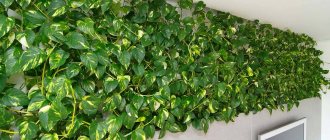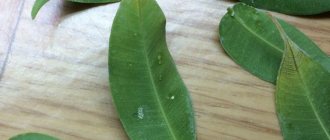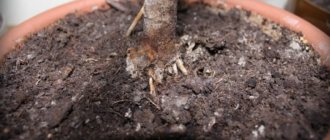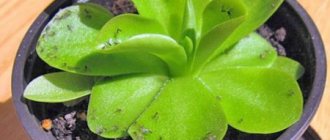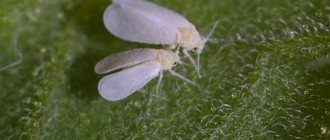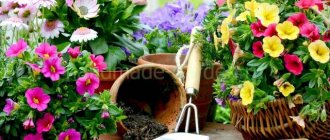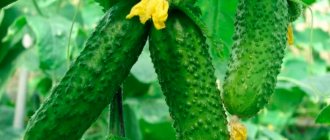Mahonia is a close relative of barberry, inferior to it in popularity, but quite capable of competing both in decorative appearance and in the taste and usefulness of its fruits. This evergreen shrub is undeservedly little cultivated in Russia due to its insufficient popularization. Meanwhile, it produces edible, tasty berries, and growing mahonia does not cause unnecessary garden troubles. Oregon mountain grapes are so called for the appearance of the fruits, which resemble bunches of grapes.
Mahonia - photo and description of the bush
In the wild, mahonia can take the form of not only a shrub, but also a full-fledged tree, however, in garden plots it is usually a bush no more than a meter high. Classified as a member of the Barberry family. Unlike barberry, mahonia shoots are not lined with thorns. The stems have a gray-pink color, atypical for garden shrubs, which becomes dark gray over the years. The root system lies superficially and actively grows in breadth, due to which it produces active root shoots. If this is not dealt with, the plant will spontaneously form dense thickets. The leaf blades have a dark, rich green, shiny front side and a matte underside of a lighter color, paired with red-brown petioles. With the onset of the first cold days of autumn, the foliage changes its color to purple-red, which looks impressive against the backdrop of dark clusters of ripe berries.
Application
The uses of Oregon grape are very wide.
In the past, Indian tribes used mahonia tea to dye fabric and leather items yellow. Today, knowing the exact recipe, you can also use the most ancient dyeing technology.
The plant also has nutritional properties. For example, it is used in the manufacture of confectionery or as a coloring component for compote, jelly or wine product. Mahonia is considered a medicinal plant, used for tinctures and decoctions. In its native country, it is actively used for medical purposes to treat disorders, gout, rheumatism, kidney diseases, liver and gall bladder. Its help is invaluable in the treatment of skin diseases, due to the presence of alkaloids in it. However, the most common use of mahonia is in landscape design. It is often used in landscaping gardens and park areas. Low shrubs are a good equivalent to a hedge. The plant harmonizes well among stones or near the walls of a house, in combination with other ornamental crops, such as roses. Bouquets with Mahonia inflorescences or leaves are not uncommon.
Flowering and fruiting
In order for Mahonia to bear fruit, cross-pollination of a pair of shrubs is required - a male and a female. The first buds appear in April, and very quickly the bush is covered with panicle inflorescences that are vaguely similar in appearance to mimosa. Flowering lasts about 2 weeks, full ripening of the berries continues until the end of summer. They hang on the branches for a long time and do not fall off. You can leave them on until winter, and they will still be just as tasty and healthy.
Mahonia fruiting begins at 3 years of age.
Interesting Facts
In America, a dye is made from mahonia. To do this, use all parts of the bush. The rhizomes and bark give a yellow tint, the leaves are green, the fruits are blue-lilac. Before chemical paints began to be used in industry, Americans actively used natural ingredients. Jeans from the famous Levi's brand were dyed with a mixture of Oregon grape berries.
Locals make a cooling drink from the berries, like our lemonade. The fruits are also used to make wonderful homemade liqueurs and wines. They have a pleasant sweetish taste and a beautiful deep purple color.
Mahonia planted on a summer cottage will delight you with its unusual appearance at all times of the year. And invigorating drinks from it will warm you in winter and bring energy in summer.
Description and photos of Mahonia varieties
The genus includes about fifty species. Of these, only three are suitable for planting in open ground in regions with a continental climate - creeping (low-growing variety), Japanese and holly. The last type is the most common, decorative and adapted for growing in Russian gardens and parks. The best and most popular varieties are:
- "Apollo". The variety was bred by Dutch breeders. It is distinguished by its slow growth, neat crown and bright appearance. Its shape, unlike other varietal varieties of mahonia holly, does not need to be carefully monitored, scrupulously pruning the shoots so that they do not turn the bush into a shapeless pile of branches. Blooms brightly and abundantly.
- "Emerald". Also bred in Holland, but not so long ago, therefore less known. The crown is more spreading and needs shaping. It is especially decorative during flowering; it blooms and bears fruit profusely. Grows up to 70 cm, tolerates frosts down to -27C without shelter.
- "Orange Frame". Throughout the summer, the foliage is brick-orange, changing color to red with the onset of cold weather.
- "Gracilis". A distinctive feature of the variety is the more elongated shape of the leaves, giving the bush a very graceful outline.
- "Aurea". Another varietal variety with a bright golden-orange crown.
- "Jaglandifolia". It stands out from others with its original shape of leaf blades, reminiscent of a walnut leaf.
Mahonia is a real find for breeders, since it easily crosses not only between its own species, but also with other representatives of the Barberry family. The reason lies in their insignificant differences, which, by and large, concern only the spikes - whether they are present or absent. The most famous and noteworthy garden hybrids.
- "Newberg Megabarberry." This is a classic hybrid obtained by crossing two basic varieties of its genus - mahonia holly and common barberry. It has excellent winter hardiness, blooms very beautifully in a bright yellow palette, and exudes a strong pleasant aroma during flowering. Can reach a meter in height.
- "Winter sun". An interesting result of crossing the Japanese variety that grows in our country with the less common Mahonia lomarielifolia. This variety blooms in winter, which is its most spectacular feature and the main difficulty of growing and caring for in cold climates. In the southern regions it grows taller than human height.
Varieties most popular among gardeners
Rose Pomponella - characteristics of the varietal shrub
The varieties presented below are winter-hardy and unpretentious in care, which attracts the attention of gardeners.
- Mahonia Apollo. The bush grows from 50 to 100 cm. The leaves are 25 cm long, have a sharp-toothed edge and consist of 7 leaf plates. In summer they are green, and in autumn they turn brown. The flowers are lemon-colored. Dark blue berries contain a waxy coating on the skin.
- Mahonia atropurpurea (Autropurpurea). The height of the bush reaches 65 cm. The leaves are dark green. They do not exceed 30 cm in length. The flowers are bright yellow.
- Mahonia Smaragd. A distinctive feature is shiny emerald-colored leaves with a clear pattern of veins.
Planting in open ground
Growing mahonia usually does not cause difficulties. The plant has a strong root system, which, despite its superficial occurrence, is capable of providing the above-ground part with moisture and nutrients with age.
Selecting a location
Mahonia is one of the crops that grow well in any soil, including heavy clay soil. However, if there is a choice, it is better to plant the shrub where the soil retains moisture well, without allowing it to stagnate. The pH reaction is preferably slightly acidic, as for all barberries. The growing root system makes transplanting an adult mahonia to a new location impossible; this must be taken into account when calculating future plans for the site. It is better to choose a place in partial shade. The bright sun will reduce the yield of the bush, but complete shade is also unacceptable, this will lead to elongation of the shoots and loss of the bright color of the foliage. Therefore, the choice of illumination depends on the purposes for which the planting is done - a decorative appearance or a rich harvest.
Mahonia does not tolerate drafts and strong winds.
Territory limitation
It should be remembered that the shrub is prone to spontaneous growth, so you need to take care in advance to create a physical barrier to limit the growth of the root system. To do this, before planting mahonia, it is recommended to dig pieces of old slate, metal panels, special garden tape, etc. around it approximately 0.5 m deep.
Planting Mahonia seedlings
Ready-made seedlings are usually purchased as a group for future cross-pollination. Their planting scheme should again be calculated based on future goals. If decorativeness is a priority, it is better to arrange the seedlings more closely, but if the future harvest is of greater interest, the distance between the bushes should be 1 m or more. The depth of the planting hole is calculated taking into account the space for drainage. The seedling is lowered onto a mound in the middle of the hole, the roots are carefully straightened along its slopes, they should not bend. It is better to trim them that are too long. It is important to keep the root collar at the same level, taking into account that the soil will shrink slightly.
If the purchased seedling has a closed root system, planting is carried out by transshipment, but a drainage layer is still required.
When to plant mahonia in open ground?
In cold regions, it is preferable to plant mahonia seedlings in early spring. In the southern regions and where spring comes quickly and quickly gives way to hot and dry summer, it is better to do this in the fall, in September or the first half of October. But not later! Planting mahonia at a later date rarely ends successfully.
Where to plant?
Mahonia grows well in shade or partial shade. This position favors the plant in the cold season, especially in early spring. If the sun heats the leaves during the day, they cool down at night, and the plant suffers from temperature changes. In partial shade, temperatures fluctuate less.
The shrub is suitable for planting under deciduous trees. However, in the shade the bush is not dense, blooms less, and is less productive. The plant especially loves places protected from cold winds.
The soil around the bush should be covered with a layer of coniferous tree bark. You can grow the plant between buildings, which “return” the heat accumulated at night. Often people cannot find what to plant under large spruce trees; very few plants can survive there, but mahonias grow well there.
Mahonia care
Only the first year will be troublesome in terms of care, until the plant adapts to the new place and grows a little. Subsequently he will require minimal care.
Watering and mulching
Regular watering will only be required for young bushes. Adult plants need it only during a long absence of rain. Loosening the soil around the trunks is highly desirable, and mulching will help retain moisture and reduce watering. And, if in summer mulching is only desirable, in preparation for winter it becomes a mandatory procedure.
Top dressing
Fertilizers should neither be neglected nor abused. Positive dynamics of growth and flowering of mahonia are observed with two applications of fertilizing during the growing season. The first time, without waiting for flowering, in early spring, as soon as the snow on the site melts and the soil dries out a little, the second time - at the very beginning of budding, i.e. after about a month. Ideally, you can alternate Nitroammofoska with Kemira Universal. NPK and liquid diluted organics also give good results.
Trimming
Pruning is not a mandatory part of caring for mahonia, but is well tolerated. To give the crown a neat appearance, you can shape it at will without harm to the well-being of the specimen, but taking into account the fact that mahonia grows quite slowly, and molding errors will not be corrected soon. Mahonia bushes often suffer from “one-sidedness,” that is, the crown grows unevenly on different sides. In open ground, the plant cannot be turned to the sun with its other side, so you will either have to put up with this or orient yourself along the smaller side, shortening the shoots on the opposite side. Radical pruning of this crop is contraindicated! It is permissible to resort to it only in cases of extreme necessity, for example, in case of ugly deformation of the bush.
Important! When pruning side shoots, the bush branches better, but this slows down its overall growth.
Preparing for winter
With good snow cover, mahonia overwinters well even without shelter, but under a dense layer of mulch. However, in regions where frosts of -30C and below are quite expected, this may not be enough, especially with low snow. To cover a low young bush, you can throw spruce branches and lightly sprinkle peat soil on top; tall bushes need to be carefully tied and tied, without tightening, with non-woven covering material. The older the bush, the easier it will survive the harsh winter. In the spring, you should not delay removing the cover to avoid overheating of the branches.
Mahonia propagation
The easiest way is to plant a ready-made mahonia seedling, but you can get new bushes in other ways.
Planting mahonia seeds
It is hardly worth recommending this method for obvious reasons, first of all, the duration of the process. Another serious disadvantage of the method is its complexity due to the need for seed stratification. And finally, it is much more difficult to buy mahonia seeds than ready-made seedlings, due to low supply. And planting seeds collected with your own hands is extremely risky in terms of results. The likelihood that new plants will inherit the characteristics of the mother bush is quite small.
If all this does not frighten you, then you need to place the seed material in the sand and, together with the container, put it in a dark, cold place for 3 months. The temperature should be positive, but not higher than +5C. Before planting, you need to keep the seeds warm for some time.
Cuttings
Cuttings are made at the end of spring or in June, for this purpose healthy semi-lignified shoots of the previous year are selected. Each one should have at least 5-6 buds, two of which are buried in the ground. Warm soil and cool air will be optimal conditions for rapid rooting.
Root suckers
There are usually no problems with this planting material; only hybrid varieties of mahonia may not produce root shoots. Agricultural technology is very simple. The young bush is cut off from the mother plant with a sharp shovel (carefully so as not to damage the root system!) and planted in a new place. The best time for this is early spring.
Stem layering
A method suitable for propagating hybrid varieties. A low-growing shoot is bent to the ground and dug in, pressed with a wire or wooden bracket. The survival rate of the shoots is high, but if the process is delayed, you can leave the bush to take root until next spring.
Use of mahonia fruits, their properties
With proper care in the fall, mahonia can be harvested with a harvest of delicious, sweet and sour dark-colored berries slightly larger than barberries. It contains red juice inside. It is better to harvest the crop not by berry, but by bunches. They often write about the presence of alkaloids in mahonia berries, making them inedible, but in fact they are concentrated in other parts of the plant - roots and bark, and to a lesser extent they are also present in the seeds. The percentage of their content in berries is considered acceptable and, moreover, desirable from the point of view of cancer prevention. All parts of mahonia have medicinal properties and are used in folk medicine. However, it is better for pregnant women to refrain from using them.
What kind of soil is needed?
The soil for mahonia should be:
- well drained;
- fertile;
- slightly damp;
- Mahonia is tolerant to the pH of the substrate, grows in acidic or slightly alkaline soil, but the leaves are most colored when the soil is slightly acidic (pH<6.5);
- Grows best on sandy, light, loamy, sandy loam soils with low calcium content.
The soil will better meet the requirements of the plant if the site is fertilized with organic matter. You can add sand to add lightness to the soil.
The soil should be mulched; mahonia does not react well to severe drying. It has shallow roots and does not tolerate transplantation in adulthood.
